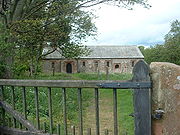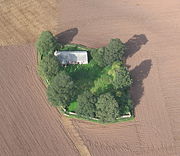
Ninekirks
Encyclopedia


Saint Ninian
Saint Ninian is a Christian saint first mentioned in the 8th century as being an early missionary among the Pictish peoples of what is now Scotland...
, was formerly the parish church of Brougham, Cumbria
Brougham, Cumbria
Brougham is a small village and civil parish on the outskirts of Penrith in the Eden District of Cumbria, England...
. It is situated on the south bank of the River Eamont
River Eamont
The River Eamont is a river in Cumbria, England and one of the major tributaries of the River Eden.The river is formed by the outflow from Ullswater in the Lake District, later augmented by Dacre Beck from the west and the River Lowther which carries the water from Haweswater north to the Eamont at...
near its confluence with the River Eden
River Eden, Cumbria
The River Eden is a river that flows through Cumbria, England on its way to the Solway Firth.-Course of river:The Eden rises in Black Fell Moss, Mallerstang, on the high ground between High Seat, Yorkshire Dales and Hugh Seat. Here it forms the boundary between the counties of Cumbria and North...
.
Importance
The Ninekirks site has been continuously occupied since at least Roman times (Simpson, 1958). The current church building is Grade 1 listed. It is one of very few to be built during the Commonwealth of EnglandCommonwealth of England
The Commonwealth of England was the republic which ruled first England, and then Ireland and Scotland from 1649 to 1660. Between 1653–1659 it was known as the Commonwealth of England, Scotland and Ireland...
and has been altered very little. (Three other churches of this age are: Church of the Holy Trinity, Berwick-on-Tweed
Church of the Holy Trinity, Berwick-on-Tweed
Berwick Parish Church is an Anglican church in Berwick-upon-Tweed, Northumberland. Set in the heart of Berwick town centre, it was built around the time of Oliver Cromwell and, therefore has no steeple.-History:...
; St Matthias Old Church
St Matthias Old Church
St Matthias Old Church is the modern name given to the Poplar Chapel built by the East India Company in 1654, in Poplar, one of the "Tower Hamlets" in the East End of London.-History:...
, London Borough of Tower Hamlets
London Borough of Tower Hamlets
The London Borough of Tower Hamlets is a London borough to the east of the City of London and north of the River Thames. It is in the eastern part of London and covers much of the traditional East End. It also includes much of the redeveloped Docklands region of London, including West India Docks...
; and Staunton Harold, Leicestershire
Leicestershire
Leicestershire is a landlocked county in the English Midlands. It takes its name from the heavily populated City of Leicester, traditionally its administrative centre, although the City of Leicester unitary authority is today administered separately from the rest of Leicestershire...
.)
Before the Norman conquest of EnglandNorman conquest of EnglandThe Norman conquest of England began on 28 September 1066 with the invasion of England by William, Duke of Normandy. William became known as William the Conqueror after his victory at the Battle of Hastings on 14 October 1066, defeating King Harold II of England...
The Ninekirks Hoard of barbarous radiateBarbarous radiate
Barbarous radiates are imitations of the antoninianus, a type of coin issued during the Roman Empire, which are so named due to their crude style and prominent radiate crown worn by the emperor....
coins (Casey, 1978) demonstrates Roman occupation of site. The area was associated with St.Ninian from a very early date (Lees, 1879) but "not everyone is convinced entirely by the arguments of Canon Bouch and others for Ninian" (Jones, 1973). There are caves nearby on the north bank of the Eamont at a site called Isis Parlis and possible evidence of occupation of these is used to support arguments in favour of early hermit
Hermit
A hermit is a person who lives, to some degree, in seclusion from society.In Christianity, the term was originally applied to a Christian who lives the eremitic life out of a religious conviction, namely the Desert Theology of the Old Testament .In the...
use.
From the Norman Conquest to Lady Anne Clifford's reconstruction
The church fell into disuse after the surrounding village was moved to near Brougham HallBrougham Hall
Brougham Hall is located in the village of Brougham just outside Penrith, Cumbria, England. The oldest part of the hall is the Tudor building, which dates back to around 1500 and was once the scene of a bloody battle between the English and Scots....
. The move took place between 1230 and 1284 (Bouch, 1950). It has been known as Ninekirks since at least 1583 (Bouch, 1950). It was reconstructed by Lady Anne Clifford
Lady Anne Clifford
Lady Anne Clifford, 14th Baroness de Clifford was the only surviving child of George Clifford, 3rd Earl of Cumberland by his wife Lady Margaret Russell, daughter of Francis Russell, 2nd Earl of Bedford...
in 1659 (Clifford, 2003).
From reconstruction to the present day
Ninekirks tended to be used when Brougham Chapel was unavailable. For example, from 1764 until the 1840s Ninekirks was used for weddings because Brougham Chapel was in need of repair work. Ninekirks was itself repaired in the 1840s. The porch was added in 1841 (RCHM, 1936) and tombs within the church were excavated in 1846 when the church was being repaired. According to Brougham (1847) these included those of Udard (or Odard) de Broham (died c.1185) and Gilbert de Broham (died c.1230). Despite the repair work, the church was poorly maintained when George Shaw visited in 1847 (Shaw, 1848).The church had a brief golden age in the early 1950s when the Rector was Canon Bouch. His publications in the Transactions of the Cumberland and Westmorland Antiquarian and Archaeological Society (1947, 1950 and 1955 (twice)) demonstrate his interest. It was made redundant
Redundant church
A redundant church is a church building that is no longer required for regular public worship. The phrase is particularly used to refer to former Anglican buildings in the United Kingdom, but may refer to any disused church building around the world...
in 1977 (Herald, 1976) and now in the care of the Churches Conservation Trust
Churches Conservation Trust
The Churches Conservation Trust, which was initially known as the Redundant Churches Fund, is a charity whose purpose is to protect historic churches at risk, those that have been made redundant by the Church of England. The Trust was established by the Pastoral Measure of 1968...
.
Hatchments
The church contains three hatchmentHatchment
A hatchment is a funeral demonstration of the lifetime "achievement" of the arms and any other honours displayed on a black lozenge-shaped frame which used to be suspended against the wall of a deceased person's house...
s, described in Boumphrey (1980):
- Elizabeth Richmond (died 1729) and Peter Brougham (died 1732)
- Eleanora Syme (died 1839) who married Henry Brougham (died 1810), father of the 1st Baron
- Henry Brougham, 1st Baron Brougham and VauxHenry Brougham, 1st Baron Brougham and VauxHenry Peter Brougham, 1st Baron Brougham and Vaux was a British statesman who became Lord Chancellor of Great Britain.As a young lawyer in Scotland Brougham helped to found the Edinburgh Review in 1802 and contributed many articles to it. He went to London, and was called to the English bar in...
(died 1868) and Mary Anne Eden (died 1865)
Archaeology
The church and its area have been the subject of at least four archaeologicalArchaeology
Archaeology, or archeology , is the study of human society, primarily through the recovery and analysis of the material culture and environmental data that they have left behind, which includes artifacts, architecture, biofacts and cultural landscapes...
investigations:
- Excavations took place inside the church during the repairs in the 1840s (Brougham, 1847) when some ancient tombs were investigated.
- Excavations at Isis Parlis in 1913 (Heelis, 1914) aiming to find out how the caves had formed and how they had been used.
- The coin hoard was discovered in 1914 (Bouch and Kent, 1955)
- Crop marksCropmarkCropmarks or Crop marks are a means through which sub-surface archaeological, natural and recent features may be visible from the air or a vantage point on higher ground or a temporary platform...
were observed in a 1968 aerial photograph (St.Joseph, 1978) consistent with a small monastic site.
See also
- Grade I listed buildings in Cumbria
- List of churches preserved by the Churches Conservation Trust in Northern England

